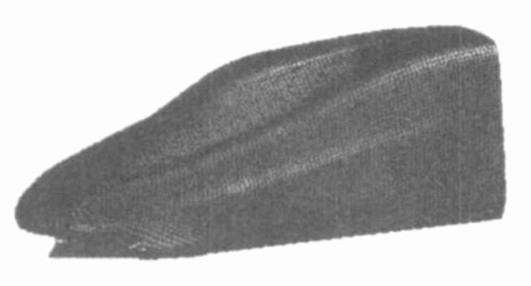Prediction of interior aerodynamic noise of high-speed train cab
Article Text (Baidu Translation)
-
摘要: 为了降低司机室内的噪声, 采用大涡模拟法计算了高速列车车头曲面的脉动压力, 将脉动压力作为头车司机室有限元分析的激励载荷, 通过谐响应分析求得司机室壁板的振动速度, 将振动速度作为司机室声场边界元模型的激励条件, 求出了司机室内的气动噪声在不同频率点的声压分布。计算结果表明: 司机室内的声压级在52.3~58.8dB (A) 之间变化, 声压级较大点位于司机室前窗玻璃向车顶过渡处及纵向中截面型线附近, 且在50~315Hz之间, 声压幅值较大; 司机室内的气动噪声主要是低频噪声, 对纵向中截面型线采取更平滑的过渡形式, 可降低司机室内的气动噪声。Abstract: In order to decrease the noise in train cab, the fluctuation pressures of head curved surface of high-speed train were calculated by using large eddy simulation method, which were exerted on the finite element model of train cab as excitement load, the vibration speeds of cab plates were obtained by using harmonic response analysis, and were taken as the excitement condition of acoustic boundary element model of train cab, and the interior aerodynamic noises at different frequencies were attained by using acoustic analysis. Computation result shows that the aerodynamic noises levels in cab change from 52.3 to 58.8 dB (A), at the transitional place from cab windowpane to train roof and near the largest outline of head longitudinal section, the noise press level (SPL) of field points are greater, the noises are dominant ranging from 50 to 315 Hz; the aerodynamic noises in cab are low frequency noises mainly, if the largest outline of head longitudinal section is smoother, the noises will be reduced.
-
Key words:
- vehicle engineering /
- high-speed train /
- cab /
- fluctuation pressure /
- aerodynamic noise
-
[1] 沈志云. 高速列车的动态环境及其技术的根本特点[J]. 铁道学报, 2006, 28 (4): 1-5. doi: 10.3321/j.issn:1001-8360.2006.04.001Shen Zhi-yun. Dynamic environment of high-speed train and its distinguished technology[J]. Journal of the China Rail way Society, 2006, 28 (4): 1-5. (in Chinese) doi: 10.3321/j.issn:1001-8360.2006.04.001 [2] Goldstein M V. Unified approach to aerodynamic sound generation in the presence of boundaries[J]. Journal of the Acoustical Society of America, 1974, 56 (2): 497-509. doi: 10.1121/1.1903283 [3] Kitagawa T, Nagakura K. Aerodynamic noise generated by Shinkansen cars[J]. Journal of Sound and Vibration2000, 231 (5): 913-924. [4] Sassa T, Sato T, Yatsui S. Numerical analysis of aerody-namic noise radiation from a high-speed train surface[J]. Journal of Sound and Vibration, 2001, 247 (3): 407-416. doi: 10.1006/jsvi.2001.3773 [5] Nagakura K. Localization of aerodynamic noise sources of Shinkansen trains[J]. Journal of Sound and Vibration, 2006, 293 (3): 547-556. [6] 刘红光, 陆森林, 曾发林. 高速车辆气流噪声的试验研究[J]. 中国公路学报, 2005, 18 (1): 113-116. https://www.cnki.com.cn/Article/CJFDTOTAL-ZGGL200501026.htmLiu Hong-guang, Lu Sen-lin, Zeng Fa-lin. Experi mental study of automobile aerodynamic noise[J]. China Journal of Highway and Transport, 2005, 18 (1): 113-116. (in Chinese) https://www.cnki.com.cn/Article/CJFDTOTAL-ZGGL200501026.htm [7] 刘红光, 陆森林. 高速车辆气流噪声计算方法[J]. 交通运输工程学报, 2002, 2 (2): 41-44. doi: 10.3321/j.issn:1671-1637.2002.02.010Liu Hong-guang, Lu Sen-lin. Calculation method of the aerodynamic noise around high speed vehicles[J]. Journal of Traffic and Transportation Engineering, 2002, 2 (2): 41-44. (in Chinese) doi: 10.3321/j.issn:1671-1637.2002.02.010 [8] Buchhei m R, Dobrzynski W, Mankau H, et al. Vehicle interior noise related to external aerodynamics[J]. International Journal of Vehicle Design, 1982, 3 (4): 398-410. [9] Peric C, Watkins S, Lindqvist E. Wind turbulence effects on aerodynamic noise with relevance to road vehicle interior noise[J]. Journal of Wind Engineering and Industrial Aerodynamics, 1997, 69 (7): 423-435. [10] Brungart T A, Lauchle G C, Deutsch S, et al. Wall pressure fluctuations of induced by separated/reattached channel flow[J]. Journal of Sound and Vibration, 2002, 251 (3): 558-577. [11] 马大猷. 噪声与振动控制工程手册[M]. 北京: 机械工业出版社, 2002. -





 下载:
下载:









